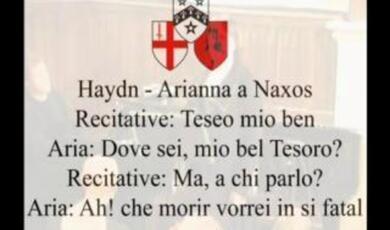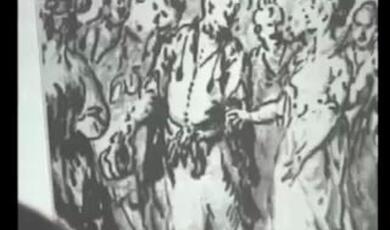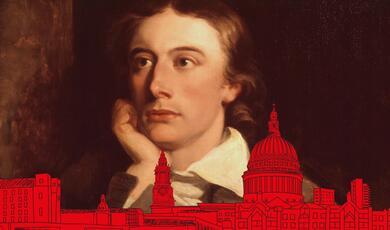St Stanislaus and Student Revelries
Share
- Details
- Transcript
- Audio
- Downloads
- Extra Reading
Download Transcript
'St Stanislaus and Student Revelries'
Professor Adrian Thomas
Introduction
Good afternoon, and welcome to the second of this year's Gresham lectures on Music, under the title 'Music in History'. Today I am picking up where I left off in the first lecture, with an example of Polish medieval song, and exploring the repertoire and historical context of Polish music from the establishment of Christianity in Poland in 996 up to the close of the 15th century. In the process, we will hear music ranging from chant to rich polyphony, with texts in Latin and in Polish, and with subject matter ranging from murder and dismemberment to religious devotion and heresy, courtly and civic duty and a student carnival. A normal music lecture, then!
Bogurodzica
In my first talk, I referred to the important functional, religious, national and musical dimensions that a study of the medieval Polish hymnBogurodzica (Mother of God) offers to Polish history. Let us remind ourselves of its text and sound-world.
MUSIC 1 Bogurodzica (v.1)
Bogurodzica dziewica, Mother of God, Virgin
Bogiem sławiena Maryja, Blessed by God, Mary,
u twego syna Gospodzina With your son, our Lord,
matko zwolena, Maryja, Chosen mother, Mary,
zyszczy nam, spuści nam Intercede for us, send [him] to us
Kyrie eleison. Kyrie eleison.
Until well into the 16th century, Bogurodzica was the Polish national anthem. It was at the same time a passionate plea, in Polish, to the Virgin Mary, and was sung, as described in his Annals by the 15th-century chronicler Jan Długosz, at several battles, notably that which the Poles won over the Teutonic knights at Grunwald in 1410. This last feature ofBogurodzica's history was repeated by subsequent commentators throughout the 16th century almost like a badge of honour in Polish military history.
Who wrote it, and when? Even though the earliest surviving manuscript dates from 1408, it would appear that the melody relates back to German sources of the litany for All Saints, perhaps as early as the 1020s - i.e., almost 400 years earlier. Alternatively, the distinguished Polish musicologist Hieronim Feicht has observed that the opening line of the melody is note for note the same as the melody of the song (pastourelle)Par desser l'ombre d'un bois by the French trouvère Jean de Braine (d.1240). 1 Over the centuries, many suggestions have been made as toBogurodzica's authorship (including some in the 16th century that it was written by St Adalbert), but recent authorities believe that there was a single, Polish author for both text and music, and that "Bogurodzicaoriginated among the educated Polish knights, who were the Polish equivalents of the French trouvères". 2 If correct, this origin - removed from plainchant and linked rather to vernacular, chivalrous and foreign traditions - speaks volumes about the interaction of music and history in the early middle ages in Poland. And when further verses were added to the original two - verses relating to Easter or addressed to a range of saints and to a Polish king - we learn even more about the centrality of this memorable song to Polish religious and cultural life.
The Beginnings of Christianity in Poland and the Murder of St Adalbert
Important though Bogurodzica is to Polish music and history, it is by no means the earliest musical manuscript in Poland. There are, as you might expect, several religious sources - mainly monastic - in which musical notation is to be found. Given that Christianity was established in Poland only when King Mieszko I was converted in 966, it is no surprise to find that the earliest surviving manuscripts date from some time later. Such sources are functional, i.e. to do with Roman Catholic liturgy and worship. More particularly, one of the earliest sources concerns the man who after his death became Poland's first patron saint: St Adalbert or, to give him his Polish name, St (święty) Wojciech. This source is called The Rhymed Office about St Adalbert and dates, as a completed manuscript, probably from the 13th century, although parts of it relate to melodies and texts found earlier elsewhere in Europe. For example, the opening antiphon 'Benedic regem cunctorum' may also be found in Graz, in Austria, in a 12th-century responsory about St Stephen.
MUSIC 2 'Benedic regem cunctorum' (Rhymed Office about St Adalbert)
What is the significance of this rhymed office? It was devised as both an historical record of Poland's first patron saint and as an educational and religious tool. Who was Adalbert? In fact, he was the Bishop of Prague, so not Polish at all, but his missionary zeal took him to Poland, then governed by King Bolesław the Brave. As Jan Długosz later recorded it.
Desiring a martyr's crown, as he himself has said, or, perhaps remembering the Pope's commission which is still in his wallet, Wojciech (Adalbert) leaves Gniezno, and, with an escort of thirty knights and courtiers … heads for the territory of the Prussians beyond Poland's frontiers … The Prussians are reputed to be a fierce, cruel people, immersed in idolatry and the worship of demonsm so blind in their errors that they worship as gods the sun, moon and stars, as well as animals, birds and fire. … It is scarcely to be wondered at that these proud people … take objection to his preaching … … one day when Wojciech, who by then has traversed more or less the length and breadth of the country proclaiming his objectionable message, comes to a settlement by the sea. There, on April 23, on a cliff by the shore he prepares to say a solemn mass for the conversion of Prussia. The Prussians … fall upon Wojciech and kill him. They sever his head and hang it up in a tree for three days.3
Eventually, as the story goes, the Polish king was compelled to pay a ransom in gold equivalent to the weight of Adalbert's body, which was then brought back to Gniezno, in central Poland, where he was buried and where a bronze door from the first half of the 12th century depicting his life and death was created for the cathedral. Two years after his death in 997, Adalbert was canonised and in the year 1000 Gniezno and the shrine to St Adalbert was the venue for an historic meeting between the Polish king and Emperor Otto III, together with the representatives of Pope Sylvester II, when the papal bull was presented that granted Poland's first archbishopric to Gniezno.
Among the many sections of The Rhymed Office is this one, 'Fulget in templo legifer' (The Lawgiver Shone Brightly in the Temple), whose third verse cites the four peoples among whom St Adalbert carried out his missionary work: Prussians (Prutenos), Hungarians (Hungariam), Poles (Polenos) and Bohemians (Czechów).
MUSIC 3 'Fulget in templo legifer' (Rhymed Office about St Adalbert)
One of the adjuncts to The Rhymed Office is 'Salve, sidus Polonorum' (Hail, Star of the Poles). And lest we think that this and the rest ofTheRhymed Office became themselves historical relics, the contemporary composer Henryk Mikołaj Górecki in 1997 marked the 1000th anniversary of Adalbert's martyrdom with his own piece, also called Salve, sidus Polonorum, in which the melody and words of the original are arranged, in a rather joyful fashion, for modern forces.
MUSIC 4 Górecki: Salve, sidus Polonorum (start of Gaudioso espressivo)
In this country, we seem to have lost contact with our patron saints on such a level. In Poland, well-known down the centuries as a fervently Roman Catholic country, there is no shortage of saints nor of occasions on which to commemorate them. But nothing compares (at least until John Paul II is canonized, as assuredly he will be) with the veneration of St Stanislaus. He was Poland's first native-born saint and, like Adalbert, met a gruesome death, this time at the hands of his King, in 1079. (Incidentally, Henryk Mikołaj Górecki has also commemorated this saint, in his oratorio-like work Beatus vir. This work was commissioned by then Cardinal Karol Wojtyła for the 900th anniversary, in 1979, of Stanislaus's murder. By the time of the premiere, in June 1979, Wojtyła had become John Paul II.)
The Cult of St Stanislaus
The story of Stanislaus, Archbishop of Kraków, and his conflict with King Bolesław II, uncannily presaged the fate of Thomas Becket 91 years later and, more recently, that of Father Jerzy Popiełuszko in Warsaw in 1984. Having fallen foul of the King, Stanislaus was beheaded by him at the Church of the Rock in Kraków, his body was "hacked into myriad pieces", as Długosz wrote, "which the King orders to be thrown here and there about the city for the dogs, vultures, crows and other predators to eat". Długosz then describes the miracle whereby, under the watchful gaze of guardian eagles, the people "carefully gather up all the red and white pieces … [and] reconstruct the whole body. That done, they suddenly see that the pieces have become a whole without trace of scar or wound." 4 In something of an irony, Stanislaus's remains were to be separated again after his canonization, which took place in 1253, 174 years after his death. As Długosz puts it, a ceremony is arranged for the day for the saint's bones to be taken from his grave. When the day comes, the city cannot accommodate the crowds that come from all over Poland and even from Hungary. The bones are taken from the grave near the south gate of the cathedral, washed with wine and held up to view to the applause and shouts of those seeking the saint's help. They are then distributed among the cathedral's churches and the more important collegiate foundations, monasteries and parish churches; but the head, hands and other important members remain together with the dust in Cracow cathedral. 5
The cult of St Stanislaus was long in the making, and a crucial role in its development was played by a Dominican friar in Kraków, Wincenty z Kielc (Vincent of Kielce, c.1200-after 1261). Wincenty had been fascinated by the story of Stanislaus since his twenties, and composed two histories, with music and text, the first titled Vita minor (c.1250) and the secondVita maior (c.1260). It appears that he knew the Rhymed Office about St Adalbert, but not, as some have alleged, a similar composition in tribute to Thomas Becket. There was also, perhaps, a political dimension: Gniezno, where Adalbert was buried, was the cradle of Polish statehood (the name Gniezno is related to the Polish for 'nest' and was indeed referred to in Latin as 'Sacer nidus' - 'Holy Nest'), while Kraków was the capital of Poland. It would look good if it, too, could lay claim to a patron saint.
Wincenty's composition - Historia gloriosissimi Stanislai - is the work of an erudite, impartial, literary and musical mind. It contains anecdotal stories of healing and miracles from the life as well as more obviously liturgical sections. Among its best-known movements are the antiphon 'Ortus de Polonia' and the hymn 'Gaude Mater Polonia' (Rejoice Mother Poland):
MUSIC 5a 'Gaude Mater Polonia' (Historia gloriosissimi Stanislai)
That recording is fairly unexceptional. As an illustration of the problems faced by today's performers in interpreting not only style but content in early music, here's a different performance in which the alternative reading of one note makes a startling difference to the sound-world of.
MUSIC 5b 'Gaude Mater Polonia' (Historia gloriosissimi Stanislai)0'32"
The note that is changed in that recording of Gaude Mater Polonia (by Ars Nova in 2003), from B flat to B natural, sounds almost a step too far. Who can say whether it is right or wrong? But undoubtedly that tritone from F to B, instead of the ore conventionally euphonious perfect 4th from F to B flat, gives the melody a much more memorable twist.
Early Sacred Music in Poland
So far, I've concentrated on the musical and literary tributes to Poland's two most significant saints. The composition of these two substantial histories, the music for which covers two CDs or more in each case, are, in a way, the exception. They have survived, which itself is something of a miracle, given the fact that great slices of Poland's heritage have been lost and destroyed through war, most devastatingly in 1939-45. The majority of the surviving medieval musical artefacts are isolated miniatures, surviving in convents and monasteries, such as those at Stary Sącz or Tyniec near Kraków. And, as supporting evidence of musical activities in these centuries, we may also take into account the carvings and paintings depicting musical instruments, more of which have survived than have musical manuscripts. Here are just a few:
OHP 1 Warriors with bugles, a carving from Wrocław (1150-1200)
OHP 2 A sculpture of King David from Trzebnica, a convent in Silesia,
now associated with St Hedwig (1220-30)
OHP 3 + 4 Two paintings from Lublin (1418)
OHP 5 A carving of angels from Kraków Cathedral (1467)
Piecing a musical history together from the manuscript and visual art remnants of the 12th to 15th centuries is harder than that faced by the citizens of Kraków in 1079. But revealing glimpses we do have.
One of these is Benedicamus Domino, dating from around 1300. It is notable for being an early piece in two parts, commonly called organum, meaning that it is essentially one melody with another marching it more or less note for note, often using open fifths and, as here especially in the second part, in parallel motion.
MUSIC 6 Benedicamus Domino I
What one may observe, in a short work like Benedicamus Domino, is that Polish sacred music from the 14th century onwards was fairly closely in touch with musical developments in Western Europe, although early on it was more distant in time. In many cases, there is evident borrowing and imitation, a feature no doubt of the movement in kings, courtiers, knights, artists and musicians. One such example is to be found in the archives of the nuns of St Clare at Stary Sącz, to the south east of Kraków. Omnia beneficia thanks God for his gifts and is composed in the style of the Notre Dame school of Paris, which flourished in the first half of the 13th century (in other words, up to a century before the composition of this gem of Polish music).
MUSIC 7 Omnia beneficia
You will have noticed that Kraków is cropping up frequently in today's talk. By the 14th century it was firmly established as the Polish capital. It had a magnificent royal castle on Wawel hill by the Vistula river, it was on the trade routes between north and south, east and west. Most importantly, Kraków became a seat of learning with the establishment of a university in 1364. I shall be returning to the Jagiellonian University at the end of this talk.
The Development of Sacred Polyphony
With the marriage of Jadwiga of Anjou (later herself to become lauded as a Polish saint, St Hedwig) and Jagiełło, Grand Duke of Lithuania, in 1386, a dynasty was launched that proved to be the most successful in Polish history.In every respect, Jagiellonian Poland - which lasted from 1386 to 1572, almost two hundred years - was the golden age for the country. Its land mass was enormous, stretching at one point from the Baltic to the Black Seas. Its military victories, its economy, its political clout and cultural and educational achievements were in many cases the equal of anywhere in Europe. And its most famous son, Mikołaj Kopernik (Nicholas Copernicus, 1473-1543), symbolises this success - we'll be looking at 'Music in the Age of Copernicus' in the fourth lecture.
And with the 15th century came musical compositions whose authors can be identified. So Wincenty of Kielce was joined, amongst others, by Mikołaj of Radom, a town to the north-east of Kraków. His complete works, those that survive, fit onto one CD. But what works! There are three sets of Credo and Gloria, and most notably a splendid Magnificat. Nicholas of Radom flourished in the first half of the 15th century, probably in the 1420s and 30s, and although virtually no details exist of his life it is widely believed that he served in the King's chapel in Kraków. His music relates to that of the 14th-century Belgian composer Johannes Ciconia, who had also served at the Polish court, and of the slightly younger French composer Guillaume Dufay (1398-1474), one of the most famous composers of his time.
MUSIC 8 Radom: Magnificat
By the mid-15th century, musical styles had advanced further, as is evidenced by an anonymous hymn, again in honour of St Stanislaus:Chwała Tobie Gospodzinie (Praise to Thee, O Lord). This piece is notable for being the oldest surviving polyphonic composition with a Polish text.
MUSIC 9 Chwała Tobie Gospodzinie
The Strange Case of Peter William of Grudziądz
We come now to the strange case of a composer who remained unidentified until the 1970s. His name in Polish is Piotr z Grudziądz, is also known as Petrus Wilhelmi of Grudencz, and I shall be returning to the issue of his name shortly. What we do now know is that Petrus (c.1400-c.1470), an almost exact contemporary of Guillaume Dufay, was admitted to the Jagiellonian University in Kraków in 1418, graduating twelve years later with two degrees. He later appeared at the Council of Basle (1431-49), where amongst other issues the Hussite heresy in Bohemia was a hot topic of disputation, and later he resided in Silesia where he died. The Czech scholar, Jaromir Cerny, has located some two dozen pieces by Petrus of Grudziądz, for one to five voices. They display an acute intelligence and mastery of polyphonic writing drawn from Burgundy and Italy, and, like Nicholas of Radom, from Guillaume Dufay. Almost all of them have a sacred or religious text (two of them, for example, are missives to two Popes). It is worth looking at them in a bit of detail.
Firstly, Prelustri elucencia is most unusual for the period in that it seems to draw directly on folk music (as we understand from the folk repertoire that we know from the 19th century onwards). Firstly, there are passages here that use the 3/4 metre and basic rhythmic pattern of the mazurka. We cannot know, of course, if the composer was in any way familiar with the folk idioms of an area of Poland around Warsaw that was a considerable distance from Kraków and Silesia. More particularly, the piece is constructed in sections alternating 2/4 and 3/4 metre, which is a feature of sizeable number of Polish folk songs from many of its regions. Whatever the truth of such surmises, the spirit of this three-part polyphonic piece is noteworthy.
MUSIC 11 Grudziądz: Prelustri elucencia
My second example is of a French-style rondeau, which illustrates a particular fashion in its treatment of both musical line and text. As you can see, it starts off with one voice, expanding to three. Effectively, it is like an extenuated round, but with each voice having its own musical line and its own text. Its cumulative effect is clear and together with its layering of texts is witness to the contemporary delight in intricate, intellectual composition. We, however, will have to make do with a purely instrumental rendition, which actually brings into sharp focus the almost Stravinskian timbres and dissonances that arise from Grudziądz's compositional practices.
MUSIC 12 Grudziądz: Promitat eterno
Have you noticed anything unusual about Petrus of Grudziądz's titles?Prelustri elucencia? Promitat eterno? Their first words begin with 'P', their second with 'e'. When Jaromir Cerny was carrying out his research, he discovered that there were many more with this phenomenon and all of them beginning with PE- continued with -TRUS. Cerny investigated further, and in one four-part work he found what he was looking for: the full name of the composer of these apparently unattributed pieces. And, you've guessed it, it was PETRUS WILHELMI DE GRUDENC. Cerny's persistence and his understanding of the medieval fascination with acrostics had solved the puzzle. The piece in question has a title that indicates the opening lines of the four superimposed texts: Veni vere - Pneuma eucaristiarum - Paraclito tripudia - Dator. So the full name emerges by the first letter of the text, reading from the second to the first and then the fourth voices:
I Veni, vere illustrator lux honoris erogator luminis muniminis iugum
II Pneuma eucaristiarum terram rigans veniarum supernorum
III -
IV Dator eya graciarum rex virtutis dux eorum numinum celestium
Here's what it sounds like!
MUSIC 13 Grudziądz: Veni vere - Pneuma eucaristiarum - Paraclito tripudia -
Dator
In works as intricate as this, we can see that the focus of sacred musical composition over the two centuries since Wincenty of Kielce composed his homage to St Stanislaus has shifted markedly, from the devotional single line where the transmission of the text to the clergy and laity alike is of paramount importance, to a mannerist utterance where the musical texture is polyphonically complex and the words virtually unintelligible.
As an antidote to the density of Petrus de Grudziądz's polyphony, let me play you one of those pieces that raise more questions than they answer. It dates from about 1447, during the last years of the Council of Basle, during which, as I mentioned earlier, the Hussite rebellion was much disputed. For those of you who, like me, are not too familiar with this major religious movement during the 15th century, it may help to outline a bit of history. It was named after the Czech reformist academic and preacher Jan Hus (1370-1415) who was branded a heretic, was imprisoned when he went to the Council of Constance in 1414 and burned at the stake on 6 July 1415. The rebellion that followed was a direct precursor of the Reformation. Hus was directly influenced by the English heretic, John Wycliffe (c. 1320/30-84), who had demanded that the Church mend its profligate ways and cede its unnecessary material possessions to the crown.
It is a measure of Wycliffe's influence that a Polish composer, Jędrzej Gałka, composed a tune, Pieśń o Wiklefie (Song about Wycliffe), whose opening lines read: "Poles, Germans, all tongues … Wycliffe speaks the truth."
MUSIC 14 Pieśń o Wyklifie
Music of the Court and City of Kraków
Not all creative attention was directed towards or against the church. And while there are fewer examples in Poland of the chivalrous lovesong or other secular topics, there are a few. Nicholas of Radom, for example, composed a secular motet in 1426 to mark the birth of a son, Prince Kazimierz (Casimir), to the King and Queen. Such a panegyric was a common feature in the poetry of the age and was often sung.
To demonstrate the close interaction between court and creative artist we need look no further than the author of the text of that motet. It was none other than Stanisław Ciołek, the King's Deputy Chancellor (1423) and subsequently Bishop of Poznań (1428). Ciołek also provided the text for the best-known song in praise of Kraków, Cracovia civitas (1428). The composer, however, remains anonymous. Here's a sample of Kraków's virtuous urban paradise, as conjured up by Ciołek in the first four verses:
O, city of Cracow, the unity
Of your inhabitants abundantly
Serves as your adornment:
A multitude of clergy, dignity of men,
And matrons with a great many children;
Riches in profusion.
You are washed by clear springs,
Guarded by shade-giving hills.
The guilty will not escape retribution,
The innocent will receive benefaction,
Everyone will encounter compassion.
In your walls rest the holy remains
Of Stanisław; the monks
Guard this relic like a treasure
In a magnificent shrine.
Here Jadwiga, mother of mothers,
Nearing her last moments of life
Takes great satisfaction.
The flower of knighthood, the scourge of enemies,
Shines with courage at your gates;
Chivalry rules everywhere.
When you hear a chant of singers
Sadness turns to soothing sweetness -
Without hostility, without wickedness
You will dance in innocence.
MUSIC 14 Cracovia civitas
Such sentiments, doffing the cap at the royal family, the city and its citizens, may seem a trifle obsequious. But it is also a celebration, couched in eloquent rhetoric that is a rare paean of praise to a medieval city.
And it is "without hostility, without wickedness" that we must contemplate the unalloyed simplicity of today's final piece of music, the student song,Breve regnum. This probably dates from around the same time as our two preceding examples, i.e. the 1420s or 1430s. Its melody, simple two-part writing and uncomplicated texture suggest the work not of a court official but of an amateur poet and musician. Breve regnum celebrates the annual student carnival at the Jagiellonian University. Its five stanzas extol the week-long juvenalia, with its election of the king of students - 'a son of Kraków blossoming like a lily'. It concludes with a wry comment about the consequent neglect of his studies:
Nam regis ellectio
et fit studii neglectio
ac desolat lectio
tota septimana. '
Twas ever thus!
MUSIC 15 Breve regnum
Playlist
1. anon. Bogurodzica (1)
2. anon. 'Benedic regem cunctorum' (Rhymed Office about St Adalbert) (4)
3. anon. 'Fulget in templo legifer' (Rhymed Office about St Adalbert) (4)
4. Górecki Salve, sidus Polonorum (10)
5. Wincenty z Kielc 'Gaude Mater Polonia' (Historia gloriosissimi Stanislai)
(two versions: 7, 1)
6. anon. Benedicamus Domino (2)
7. anon. Omnia beneficia (1)
8. Mikołaj z Radomia Magnificat (5)
9. anon. Chwała Tobie Gospodzinie (9)
10. Petrus de Grudziądz Prelustri elucencia (8)
11. Petrus de Grudziądz Promitat eterno (8)
12. Petrus de Grudziądz Veni vere - Pneuma eucaristiarum - Paraclito tripudia - Dator (3)
13. Jędrzej Gałka Pieśń o Wyklifie (LP: Muza XL 0294)
14. anon. Cracovia civitas (6)
15. anon. Breve regnum (9)
Selected Discography
(1) Bogurodzica. Polish Medieval Music, Ars Nova (DUX 0316, 2003)
(2) One Thousand Years of Music in Cracow, Capella Cracoviensis (CCF 05)
(3) Codex Speciálnik. Music from a Prague Manuscript c.1500, The Hilliard Ensemble (ECM 1504, 1995) - includes four pieces by Petrus de Grudencz)
(4) Officium rymowane o św. Wojciechu (The Rhymed Office about St Adalbert) 'Benedic Regem Cunctorum', Lektorska Schola Cantorum, Wiesław Kądzieła (conductor) (Pro Musica Camerata PMC 015/016, 1997)
(5) Mikołaj z Radomia: Dzieła Wszystkie (Complete Works), Ars Nova (DUX 0229, 1995)
(6) Muzyka na Wawelu (Music on Wawel), Ars Nova (DUX 0216, 1995)
(7) Wincenty z Kielc: Historia gloriosissimi Stanislai (The Glorious History of Stanislaus), Lektorska Schola Cantorum, Wiesław Kądzieła (conductor) (Pro Musica Camerata PMC 005)
(8) Petrus de Grudziadz: Chansons et Motets, Bornus Consort, Ensemble Ars Nova de Varsovie (Accord 201412, 1991)
(9) Musique à la Chapelle des Jagellons, Ensemble Ars Nova, Varsovie (Accord 201032, 1990)
(10) Henryk Mikołaj Górecki: Beatus Vir op.38 (1979), Salve, Sidus Polonorum, op.72 (1997), Adam Kruszewski (baritone), Polish Radio Choir (Kraków), Polish Radio Choir and Orchestra (Katowice), Henryk Mikołaj Górecki (conductor) (Polish Radio PRCD 063, 2004)
1 Hieronym Feicht, 'Poland's First Vernacular Hymn "Bogurodzica" ("The Mother of God") in Jerzy Braun, ed., Poland in Christian Civilization(London, 1985), 136
2 ibid., 137
3 Długosz, Jan. The Annals of Jan Długosz. A History of Eastern Europe from A.D. 965 to A.D. 1480 (Chichester, 1997), 8-9
4 Długosz, 58
5 Długosz, 197
6 Michael J. Mikoś (selector and translator), Polish Literature from the End of the Middle Ages to the End of the Eighteenth Century. A Bilingual Anthology (Warsaw: Constans, 1999), 131-3
© Professor Adrian,Thomas Gresham College, 3 November 2005
This event was on Thu, 03 Nov 2005
Support Gresham
Gresham College has offered an outstanding education to the public free of charge for over 400 years. Today, Gresham plays an important role in fostering a love of learning and a greater understanding of ourselves and the world around us. Your donation will help to widen our reach and to broaden our audience, allowing more people to benefit from a high-quality education from some of the brightest minds.


 Login
Login







